Definition
Fact family is a collection of related addition and subtraction facts, or multiplication and division facts, made from the same numbers.
Example
For the numbers 6, 7, and 13, the addition and subtraction fact family consist of 6 + 7 = 13, 7 + 6 = 13, 13 – 6 = 7, 13 – 7 = 6.
Rules of Fact Family
To be a part of the fact family, there are some rules.
Rules for Addition / Subtraction Fact Family
- There must be two smaller numbers (called part) which on adding will give the bigger number (called whole) of the family.
- There can be two numbers in the family, if the smaller number on addition with itself gives bigger number.
- The bigger number, when a small number is subtracted from it, should give the other small number.

Rules for Multiplication / Division Fact Family
- Two smaller numbers on multiplication should give the larger number.
- Dividing bigger number by the smaller number should give the other smaller number of the family.
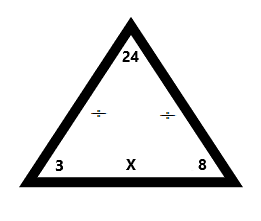
Fact Families for Addition/Subtraction
Some examples of fact families for addition and subtraction are given below.
Fact Families with Number 12
The fact families that involve the number twenty (20) in addition and subtraction are given below.
Numbers 2, 10, and 12
The three numbers 2, 10, and 12 makes a fact family such that their addition and subtraction give other number of the family.
When we add 2 and 10, we get 12. Similarly, when we add 10 and 2, we get 12 which is the third member of the family.
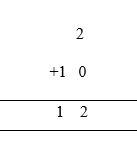
Similarly, if we subtract 2 from 12 such that 12 is the minuend and 2 is subtrahend. We get 10 as the difference. 10 is the member of the family.

If we subtract 10 from 12 such that 12 is the minuend and 10 is subtrahend, then the difference is 2 which belongs to the fact family.
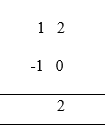
So, when we add or subtract two of these three numbers, they give the third number of the family. That is why they are said to be in a fact family.
Numbers 4, 8, and 12
The three numbers 4, 8, and 12 makes a fact family such that their addition and subtraction give other number of the family.
When we add 4 and 8, we get 12. Similarly, when we add 8 and 4, we also get 12 which is the third member of the family.

Similarly, if we subtract 8 from 12 such that 12 is the minuend and 8 is subtrahend. We get 4 as the difference. Four (4) is the member of the family.

If we subtract 4 from 12 such that 12 is the minuend and 4 is subtrahend, then the difference is 8 which belongs to the fact family.
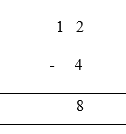
So, when we add or subtract two of these three numbers, they give the third number of the family. That is why they are said to be in a fact family.
Numbers 7, 5, and 12
The three numbers 7, 5, and 12 makes a fact family such that their addition and subtraction give other number of the family.
When we add 7 and 5, we get 12. Similarly, when we add 5 and 7, we also get 12 (Commutative property of addition) which is the third member of the family.
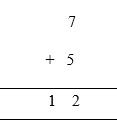
Similarly, if we subtract 7 from 12 such that 12 is the minuend and 7 is subtrahend. We get 5 as the difference. Five (5) is the member of the family.
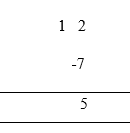
If we subtract 5 from 12 such that 12 is the minuend and 5 is subtrahend, then the difference is 7 which belongs to the fact family.

So, when we add or subtract two of these three numbers, they give the third number of the family. That is why they are said to be in a fact family.
Numbers 3, 9, and 12
The three numbers 3, 9, and 12 makes a fact family such that their addition and subtraction give other number of the family.
When we add 3 and 9, we get 12. Similarly, when we add 9 and 3, we also get 12 which is the third member of the family.
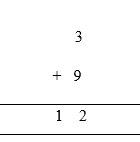
Similarly, if we subtract 9 from 12 such that 12 is the minuend and 9 is subtrahend. We get 3 as the difference. Three (3) is the member of the family.
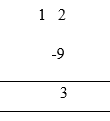
If we subtract 3 from 12 such that 12 is the minuend and 3 is subtrahend, then the difference is 9 which belongs to the fact family.
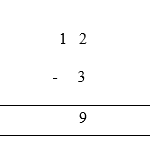
So, when we add or subtract two of these three numbers, they give the third number of the family. That is why they are said to be in a fact family.
Numbers 11, 1, and 12
The three numbers 11, 1, and 12 makes a fact family such that their addition and subtraction give other number of the family.
When we add 11 and 1, we get 12. Similarly, when we add 1 and 11, we also get 12 which is the third member of the family.
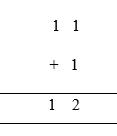
Similarly, if we subtract 1 from 12 such that 12 is the minuend and 1 is subtrahend. We get 11 as the difference. Eleven (11) is the member of the family.
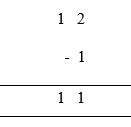
If we subtract 11 from 12 such that 12 is the minuend and 11 is subtrahend, then the difference is 1 which belongs to the fact family.

So, when we add or subtract two of these three numbers, they give the third number of the family. That is why they are said to be in a fact family.
Numbers 6 and 12
This is an example of fact family that involves two numbers only. Those numbers are 6 and 12 makes a fact family such that their addition and subtraction give other number of the family.
When we add 6 and 6, we get twelve (12) which is the third member of the family.

Similarly, if we subtract 6 from 12 such that 12 is the minuend and 6 is subtrahend. We get 6 as the difference. Six (6) is the member of the family.
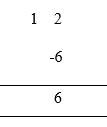
So, when we add or subtract these numbers, the result is a number which is either 6 or 12. Hence, belong to the same family. That is why they are said to be in a fact family.
Fact Families with Number 20
Following are some of the fact families that involve the number twenty (20) in addition and subtraction only.
Numbers 1, 19, and 20
The three numbers one (1), nineteen (19), and twenty belongs to fact family. Their addition and subtraction give other number of the family. We will prove it here in this section.
When we add one (1) and nineteen (19), we get twenty (20). Similarly, when we add 19 and 1, we also get 20 which is the third member of the family.
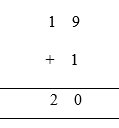
Similarly, if we subtract 19 from 20 such that 20 is the minuend and 19 is subtrahend. We get 1 as the difference. One (1) is the member of the family.

If we subtract 1 from 20 such that 20 is the minuend and 1 is subtrahend, then the difference is 19 which belongs to the fact family.
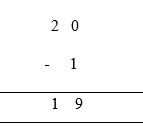
Hence, one can observe that when we add or subtract two of these three numbers, they give a third number of the family. That is why they are said to be in a fact family.
Numbers 2, 18, and 20
The three numbers two (2), eighteen (18), and twenty (20) belongs to fact family. Their addition and subtraction give other number of the family. We will prove it here in this section.
When we add two (2) and eighteen (18), we get twenty (20). Similarly, when we add 18 and 2, we also get 20 (this obviously is result of commutative law of addition) which is the third member of the family.

Similarly, if we subtract 2 from 20 such that 20 is the minuend and 2 is subtrahend. We get 18 as the difference. Eighteen (18) is the member of the family.

If we subtract 18 from 20 such that 20 is the minuend and 18 is subtrahend, then the difference is 2 which belongs to the fact family.
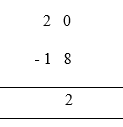
Hence, one can observe that when we add or subtract two of these three numbers, they give a third number of the family. That is why they are said to be in a fact family.
Numbers 3, 17, and 20
The three numbers 3, 17, and 20 belongs to fact family. Their addition and subtraction give other number of the family. We will prove it here in this section.
When we add three (3) and seventeen (17), we get twenty (20). Similarly, when we add 17 and 3, we also get 20 (this obviously is result of commutative law of addition) which is the third member of the family.

Similarly, if we subtract 3 from 20 such that 20 is the minuend and 3 is subtrahend. We get 17 as the difference. Seventeen (18) is the member of the family.
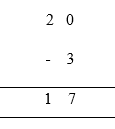
If we subtract 17 from 20 such that 20 is the minuend and 17 is subtrahend, then the difference is 3 which belongs to the fact family.
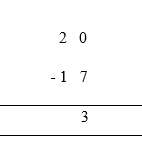
Hence, one can observe that when we add or subtract two of these three numbers, they give a third number of the family. That is why they are said to be in a fact family.
Numbers 4, 16, and 20
The three numbers four (4), sixteen (16), and twenty (20) belongs to fact family. Their addition and subtraction give other number of the family. We will prove it here in this section.
When we add four (4) and sixteen (16), we get twenty (20). Similarly, when we add 16 and 4, we also get 20 (this obviously is result of commutative law of addition) which is the third member of the family.
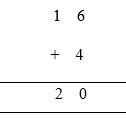
Similarly, if we subtract 4 from 20 such that 20 is the minuend and 4 is subtrahend. We get 16 as the difference. Sixteen (16) is the member of the family.
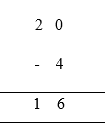
If we subtract 16 from 20 such that 20 is the minuend and 16 is subtrahend, then the difference is 4 which belongs to the fact family.
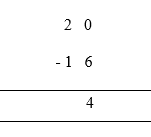
Hence, one can observe that when we add or subtract two of these three numbers, they give a third number of the family. That is why they are said to be in a fact family.
Numbers 5, 15, and 20
The three numbers five (5), fifteen (15), and twenty (20) belongs to fact family. Their addition and subtraction give other number of the family. We will prove it here in this section.
When we add five (5) and fifteen (15), we get twenty (20). Similarly, when we add 15 and 5, we also get 20 (this obviously is result of commutative law of addition) which is the third member of the family.
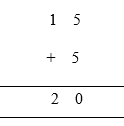
Similarly, if we subtract 5 from 20 such that 20 is the minuend and 5 is subtrahend. We get 15 as the difference. Fifteen (15) is the member of the family.
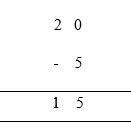
If we subtract 15 from 20 such that 20 is the minuend and 15 is subtrahend, then the difference is 5 which belongs to the fact family.
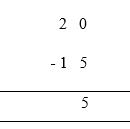
Hence, one can observe that when we add or subtract two of these three numbers, they give a third number of the family. That is why they are said to be in a fact family.
Numbers 6, 14, and 20
The three numbers six (6), fourteen (14), and twenty (20) belongs to fact family. Their addition and subtraction give other number of the family. We will prove it here in this section.
When we add six (6) and fourteen (14), we get twenty (20). Similarly, when we add 14 and 6, we also get 20 (this obviously is result of commutative law of addition) which is the third member of the family.
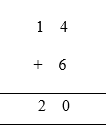
Similarly, if we subtract 6 from 20 such that 20 is the minuend and 6 is subtrahend. We get 14 as the difference. Fourteen (14) is the member of the family.
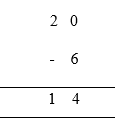
If we subtract 14 from 20 such that 20 is the minuend and 14 is subtrahend, then the difference is 6 which belongs to the fact family.
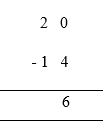
Hence, one can observe that when we add or subtract two of these three numbers, they give a third number of the family. That is why they are said to be in a fact family.
Fact Families for Multiplication/Division
Some examples of fact families for multiplication and division are given below.
Fact Families with Number 24
The fact families that involve the number twenty-four (24) in multiplication and division are given below.
Numbers 2, 12, and 24
The numbers two, twelve, and twenty-four belongs to a fact family. This is because if we multiply or divide any two of these numbers, they give third number of the family. This will be proved in this section.
When we multiply 2 and 12, we get 24. Similarly, on multiplying 12 and 2 we again get 24, this is because multiplication is commutative. In either case, 24 is the answer which is the third member of the family.
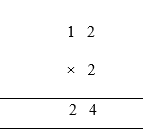
Dividing one number by other is opposite / reciprocal to multiplication. If we divide 24 by 12, here 24 is dividend whereas 12 is divisor. The result of division is called quotient, which in our case is 2.
Dividing 24 by 12 means 12 × ___ = 24. Now, start revising the 12 times table. And we can see that 12 × 2 = 24. Hence, 2 is the quotient / answer of the division. This quotient 2 is in the fact family.
Now, let’s divide 24 by 2, we must be revising the 2 – times table because 2 × ___ = 24. The answer is 12 because 2 × 12 = 24. We can say that 12 is the quotient and most importantly it belongs to the fact family.
Thus, we conclude in this example that 2, 12, and 24 belongs to one fact family and when we divide or multiply two of these numbers, it gives the other number of the family.
Numbers 3, 8, and 24
The numbers three, eight, and twenty-four belongs to a fact family. This is because if we multiply or divide any two of these numbers, they give third number of the family. This will be proved in this example.
When we multiply 3 and 8, we get 24. Similarly, on multiplying 8 and 3 we again get 24, this is because multiplication is commutative. In either case, 24 is the answer which is the third member of the family.
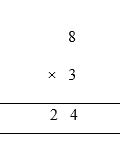
If we divide 24 by 8, here 24 is dividend whereas 8 is divisor, it means 8 × ___ = 24. Now, start revising the 8 – times table. And we can see that 8 × 3 = 24. Hence, 3 is the quotient / answer of the division. This quotient 3 is in the fact family.
Now, let’s divide 24 by 3, we must be revising the 3 – times table because 3 × ___ = 24. The answer is 8 because 3 × 8 = 24. We can say that 8 is the quotient and most importantly it belongs to the fact family.
Thus, we conclude in this example that 3, 8, and 24 belongs to one fact family and when we divide or multiply two of these numbers, it gives the other number of the family.
Numbers 6, 4, and 24
The numbers six, four, and twenty-four belongs to a fact family. This is because if we multiply or divide any two of these numbers, they give third number of the family. This will be proved in this example.
When we multiply 6 and 4, we get 24. Similarly, on multiplying 4 and 6 we again get 24, this is because multiplication is commutative. In either case, 24 is the answer which is the third member of the family.
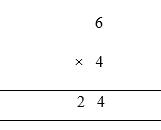
If we divide 24 by 6, here 24 is dividend whereas 6 is divisor, it means 6 × ___ = 24. Now, start revising the 6 – times table. And we can see that 6 × 4 = 24. Hence, 4 is the quotient / answer of the division. This quotient 4 is in the fact family.
Now, let’s divide 24 by 4, we must be revising the 4 – times table because 4 × ___ = 24. The answer is 6 because 4 × 6 = 24. We can say that 6 is the quotient and most importantly it belongs to the fact family.
Thus, we conclude in this example that 4, 6, and 24 belongs to one fact family and when we divide or multiply two of these numbers, it gives the other number of the family.
Note
There are two conditions that we must note.
- While adding within the fact family, always add the smaller numbers.
- While multiplying within the fact family, always multiply the smaller number to ensure that the resulting number lies in the family.
- While subtracting within the fact family, the minuend must be the largest number of the family.
- While division within the fact family, the dividend must be largest number of the family.
Word Problem
A boy had eight bags in total. He gave two of the bags to his friend. Find how many bags the boy is left with? Also find out whether the numbers belong to fact family or not?
Solution
The boy had eight bags in total, means 8 is minuend. He gave 2 to his friend, therefore two (2) is subtrahend. Number of bags he is left with can be calculated using simple subtraction.
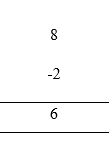
The boy is left with six bags. Now to shows that these numbers six, two, and eight belong to fact family, we must add the smaller number.

The answer is eight which is one of the three numbers, hence we can say that the three numbers belong to one fact family.
References
| [1] | “HomeSchoolMath.net,” HomeSchoolMath.net, 2003. [Online]. Available: https://www.homeschoolmath.net/teaching/a/fact_families.php. [Accessed 24 9 2021]. |
| [2] | “Philadelphia Montessori Charter School,” Philadelphia Montessori Charter School, [Online]. Available: https://www.philadelphiamontessori.org/apps/news/show_news.jsp?REC_ID=287776&id=3. [Accessed 20 9 2021]. |
| [3] | “SplashLearn,” StudyPad Inc., 2020. [Online]. Available: https://www.splashlearn.com/math-vocabulary/number-sense/fact-family. [Accessed 20 9 2021]. |
| [4] | “twinkl,” twinkl, 2021. [Online]. Available: https://www.twinkl.com.pk/teaching-wiki/fact-family. [Accessed 23 9 2021]. |
| [5] | “Everyday Math,” Everyday Math, 2021. [Online]. Available: https://everydaymath.uchicago.edu/parents/2nd-grade/em4-at-home/vocab/2-3-3-fact-family.html. [Accessed 23 9 2021]. |









